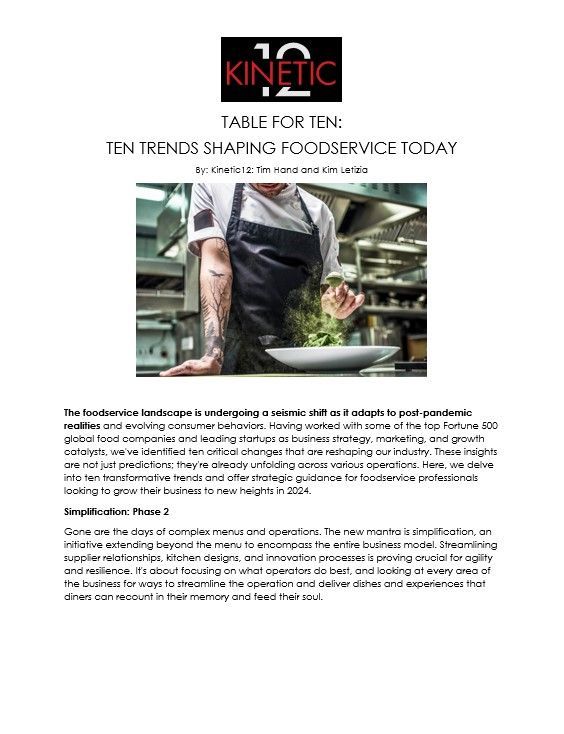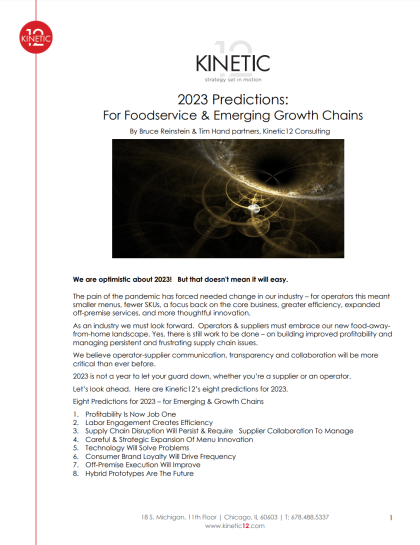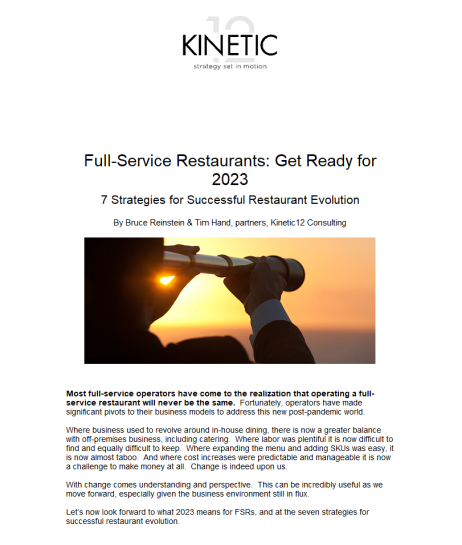Full-Service Restaurants: Get Ready for 2023
7 Strategies for Successful Restaurant Evolution
Most full-service operators have come to the realization that operating a full-service restaurant will never be the same. Fortunately, operators have made significant pivots to their business models to address this new post-pandemic world.
Where business used to revolve around in-house dining, there is now a greater balance with off-premises business, including catering. Where labor was plentiful it is now difficult to find and equally difficult to keep. Where expanding the menu and adding SKUs was easy, it is now almost taboo. And where cost increases were predictable and manageable it is now a challenge to make money at all. Change is indeed upon us.
With change comes understanding and perspective. This can be incredibly useful as we move forward, especially given the business environment still in flux.
Let’s now look forward to what 2023 means for FSRs, and at the seven strategies for successful restaurant evolution.
Seven Strategies for Successful Restaurant Evolution
1. Being Open-Minded & Flexible - Step one is to take emotion out of decision making. Great leaders listen to their teams, customers, and partners and make decisions based on fact, perspective, and experience. The road ahead is clearer than it has been the last few years but will still require flexibility. It shouldn’t require a pandemic to make change. Operators must be willing to let go, to try a new way that allows for sales growth, cost reduction, and most importantly, greater profitability.
2. Keep the Menu Simple & LTO Strategy Tight - Many full-service restaurants historically operated based upon a “more is better” mentality and trying to be everything for everybody. This mindset changed over the last three years due to shortages of labor and supply. “More”, as it turned out, was not better -- it was inefficient and costly. Operators learned that consumers did not need all these menu items and in fact embraced simplicity and appreciated that a restaurant was focused on doing fewer things really well.
In 2023, we see menus continuing to be condensed, easy to execute and more profitable, yet still every bit as satisfying for the consumer. We also see the pace of LTOs increasing but requiring fewer new SKUs. In general, SKU reduction will continue, and news SKUs will be challenged to carry their weight, either through use on multiple recipes or by being truly differentiated and value-added.
3. Mold Your Model: Become a Hybrid - The history of most full-service restaurants involves large dining areas with even larger menus. Take-out business was an after-thought, packaging was cheap, and the quality of the experience was average at best. COVID changed that. Being better at take-out was required to survive. Post-pandemic we’ve seen the share of off-premise settle in significantly higher than it was. Big dining rooms are not as important. A restaurant’s digital platform has become crucial to customer engagement, driving traffic and business viability. Menus have become smaller. How staff is deployed has changed. All of these forces of changes have caused full-service operators to rethink their business model, and rightly so.
2023 will bring us more examples of FSR hybrid models. These will take on some of the successful characteristics of Fast Casual and QSRs, but maintain full-service, but in a more compact system.
4. Be Great at Off-Premise – For many consumers the pandemic was a giant forced-trial experience in off-premise Foodservice. And as it turned out, they liked it! What started with social distancing has become about convenience. Restaurant take-out as a result has improved. It’s gotten easier to order and easier to get. Off-premise menus and promotions now offer more choice and delivery packaging has improved. The whole experience is better – and we predict this up-scaling will continue to be a major focus of investment in 2023.
From a menu perspective, menu items that are consumed off-premise must now meet the quality standards of the products that are consumed at the restaurant. That is what the consumer wants. Their expectations have increased. They now expect to have a great experience whether dining in-house or off-premise. The game has changed. We predict this new evolution to better off-premise Foodservice may be the biggest impact from COVID on our industry.
5. Create a Culture of Labor Productivity & Efficiency – “Doing more with less” will become the industry standard in 2023. After 2 years of experience in the new labor shortage market, operators understand that staff engagement and building the right culture is essential to survival. It will start with team members who are well trained, who are listened to and feel appreciated, have a quality way of life, are competitively compensated, see opportunities to grow, and have fun at work.
A second critical element to engagement is to have managers who manage not “firefight”. This will be a major challenge and focus in 2023. Managers who work in an engagement-culture are likely to stay and grow with a company. On the other hand, firefighters tend to move on which leads to further staffing problems.
6. Embrace Technology – Clearly operators must prioritize where they invest in technology but it’s tricky to determine what is the best system for their operation. Over the last few years full-service operators have accelerated their investments in tabletop ordering, delivery tech, apps, websites, inventory management software, KDS, online training, and more. We can expect the pace of innovation in Foodservice technology to continue in 2023 and full-service operators will need to embrace this tech to stay competitive. We are now in a new environment where operations management, training and customer connectivity must have a foundation in technology. Investing smartly will drive traffic, create loyalty, lead to more effective training, improve team engagement, improve their manager’s productivity, and drive greater revenue.
7. Re-Invent Your Supply Chain - Many brands are using the same products as before the pandemic but paying more for them and still living with sporadic supply chain issues. Is there a better way? In the year ahead we expect more brands to further re-invent their supply chains. To do so full-service operators must work closely with their preferred supplier partners to build a supply model they can rely on. This requires approved alternative products, elimination of some proprietary products in favor of branded SKUs that are more readily available and being open to protein alternatives that provide more consistent availability and cost. It also demands a higher level of transparency and communication. Suppliers that cannot step up will be cut. Product supply is critical to a restaurant’s success and operators have run out of patience. 2023 will see a new era of supply chain management as a result.
TELLING A NEW STORY – a bonus thought
2023 is the year to re-invent your brand. Every restaurant brand can be improved. Be forward-thinking determine out how to appeal to today’s consumer or how to be even more compelling to your existing core customers. Become an innovative growth brand with real areas of differentiation. Re-invent who you are, if needed. These seven strategies are critical to running a great operation, but they don’t tell the whole story. Create your own story. Tell your story!
______________________________________________________________________________________________
Bruce Reinstein and Tim Hand are partners with Kinetic12 Consulting, a Chicago-based Foodservice and general management consulting firm. The firm guides multiple best practice projects and forums, and works with leading Foodservice suppliers, operators, and associations. Their previous leadership roles in restaurant chain operations and at Foodservice manufacturers provide a balanced industry perspective.
Contact us to talk: Bruce@Kinetic12.com, or Tim@Kinetic12.com



